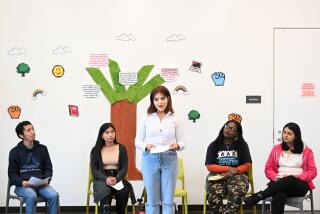New K-12 elective: class online
After Ben Hathaway’s father was called to active duty in the Army National Guard, the 15-year-old had to help his family tend the 130 head of cattle on their 345-acre farm in Leoma, Tenn. Traditional school burned through too many daylight hours, so Hathaway started taking online classes through Lutheran High School of Orange County, some 1,750 miles away.
“Mom was having trouble running the farm by herself,” Hathaway, who is taking algebra and world history online, said in a phone interview. “You can schedule everything on your own time. You don’t have to sit for six hours a day -- you can do some work, go eat, play a little on the computer and come back later and do it.”
Hathaway, who hopes to be a novelist, is among 1 million kindergarten through high school student enrollments in virtual schooling across the nation, according to the North American Council for Online Learning, a nonprofit organization for administrators, teachers and others involved in online schooling.
Enrollment, counted as the total number of seats in all online classes, not the number of students, has grown more than 20 times in seven years, and the group expects the numbers to continue to jump 30% annually.
To deal with the growth, the University of California is launching an extensive effort to make sure applicants’ online high school courses are on par with traditional classroom instruction.
Nearly half the states offer public school classes online, and last year Michigan became the first in the nation to require students to take an online course to graduate from high school. In California, a state senator introduced a bill last week to allow public high school students to take online classes without depriving schools of the state funding they receive for attendance.
Online learning “is going to reinvent high school in the United States,” said Ken Ellwein, executive director of Lutheran High School of Orange County, which created its online school last year.
“To keep technology away from kids while they’re going to school, when they have it in every other part of their lives -- it just doesn’t make sense.”
But other educators urged caution, noting that teacher-student interaction is irreplaceable.
“In the classroom, I can see from a child’s eyes or body language, ‘Boy, I better slow down and go back over this,’ ” said Gerry Wheeler, a former physics teacher who is executive director of the National Science Teachers Assn. in Arlington, Va.
The U.S. Department of Education plans to release a study about the prevalence of online schooling later this year. But one survey the department completed nearly five years ago found that 36% of school districts in the nation had students enrolled in virtual school, mostly high school students.
“We’ve certainly seen an increase,” said Tim Magner, director of the department’s Office of Educational Technology. “It’s growing fast.”
He said students often enroll in online classes to take Advanced Placement or other specialty courses not available in their local schools. Making up a failed class or adding courses that would not otherwise fit in a student’s schedule are other top reasons, he said.
Online schools are also popular with home-schooled children, with students who are devoting large blocks of time to such activities as ballet, acting or tennis, as well as students who don’t enjoy a traditional school atmosphere or who need to work.
“It’s not a matter of intellect or aptitude. The most important factor would be the [student’s] desire,” said Patty Young, director of Orange Lutheran Online. “Students today really want a customized education. Why should school be confined to an old-style box with a daily schedule?”
Paul Riscalla, 17, a senior at Orange Lutheran who lives in Orange, splits his time between online classes and the traditional school so he can work 40 hours a week at two jobs and play drums in a rock band.
“It was a way for me to have more time outside school, because I have a lot of stuff going on,” he said.
Other parts of the nation have a head start on virtual schooling, with 24 states running online schools. Nearly 30,000 students take classes at Florida Virtual School, which has a $43-million annual budget and, at nearly a decade old, is the nation’s oldest and largest statewide online public school.
“Many states are realizing the world is moving in this direction, and we need to prepare kids to be able to work and exist in this type of environment,” said Julie Young, co-founder of the Florida school.
In California, online schools are run through private schools such as Orange Lutheran, as well as public schools, universities and businesses.
The Orange County Department of Education runs Pacific Coast High School, an independent-study program that offers online and hybrid classes popular among home-school families, that has 421 students enrolled. Students from kindergarten through high school are filling the equivalent of 10,000 classroom seats in Stanford University’s online program for gifted students, and in September the university launched a selective online high school.
Los Angeles Unified School District created the Los Angeles Virtual Academy in 2005 to increase access to college prep courses, advanced placement classes and remedial algebra. About 500 students from eight high schools and one middle school take classes there, an increase of about 100 students over last year.
Orange Lutheran’s online school, created because enrollment at the 1,150-student school was at capacity, began accepting students in the fall of 2005. Currently, 243 are enrolled in 21 courses offered in eight-week semesters. More than half the students have never set foot on the school’s 12 1/2-acre campus, while the remainder are Lutheran High School students who split their time between the traditional school and online learning.
Virtual students at Orange Lutheran must log into their classes daily and read lectures, answer questions, participate in class discussions on message boards and do homework. Students are free to schedule their schoolwork whenever it suits them, as long as they log in daily.
Students pay $300 per half-credit if enrolled full time at the online school and $400 per half-credit if enrolled part time. Students who opt to complete their high school education entirely online could earn their diplomas a year early. Those enrolled full time can take part in the athletics and extracurricular events at Lutheran High. Enrollment online only would cost roughly $4,200 a year, significantly less than the traditional school’s annual tuition of $7,000 to $10,000.
The rigor of the curricula and the interaction between the instructors and the students are what make online courses successful, Ellwein said.
“It’s not a correspondence course,” he said. “What we do here -- it’s a classroom. Kids are in the classroom every day. You have incredible feedback. It’s not an easy credit.”
Students can receive a high school diploma through the program, but to be eligible for UC admission, they must complete science labs at the traditional school.
The University of California has seen such an increase in applicants taking online courses that last fall the faculty established criteria for evaluating the classes, said Susan Wilbur, UC’s director of undergraduate admissions. Under the new policy, all online course providers must be approved by UC, and then each online course must be evaluated to determine whether it meets UC admissions requirements.
Currently, the 10-campus university grants credit for online courses taken only through its own online college prep program; through Cyber High, an online school run through the Fresno Unified School District; or -- the most common route -- if a principal at an accredited school will accept an online course and include it on a student’s transcript.
The only courses students cannot take wholly online are science classes such as biology and chemistry, which require hands-on lab experience, although Wilbur said she expected this to be an issue that UC faculty would discuss.
“The most important message I would like to convey is that the faculty recognizes that we are in a changing education environment and are certainly open to considering alternatives, but we have not seen anything yet that meets the [lab sciences] requirements,” she said.
Another concern is cheating. Online educators concede that a sibling, friend or parent could complete an online student’s classwork, but, they say, the same people could also complete a traditional student’s homework. Online schools have various strategies to discourage cheating. Florida Virtual, for example, requires that students complete tests on the phone with their instructor.
For students taking classes unavailable in their own schools, online education has proven results. According to the council for online learning, Advanced Placement test pass rates for students who take the preparatory courses online are 10% higher than the national average.
Other educators and psychologists worry about the loss of social interaction among students who are taking online coursework exclusively to avoid the stress of attending a traditional high school.
“When I see a kid walk into my classroom, I know if there’s a problem,” said Alan Warhaftig, an English teacher at the Fairfax Magnet Center for Visual Arts in Los Angeles who wrote “Web-Based Learning: But the Prom Will Not Be Webcast” in the trade newspaper Education Week. “Kids need to learn how to interact with each other and adults. If they are in splendid isolation, they are missing socialization experiences at school ... how to discuss, how to listen, how to read people’s visual cues.”
Hathaway concedes that he has lost out on some interaction and high school traditions, such as the dances, since he started taking online classes full time. But he doesn’t miss the pressure to conform and to be part of the in-crowd. His father, Lt. Col. Kevin Hathaway, said the online courses are more rigorous than the local school system, and have helped his son develop responsible work habits.
“I get a better education, and I just didn’t want to go through the pressures of high school,” Ben Hathaway said. “You do lose a lot of contact with other friends, but you get to meet new ones along the way. I get to meet new people from all over the place.”
More to Read
Sign up for Essential California
The most important California stories and recommendations in your inbox every morning.
You may occasionally receive promotional content from the Los Angeles Times.











